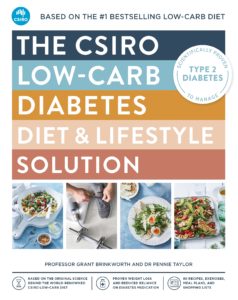Global S&T Development Trend Analysis Platform of Resources and Environment
| Low carb lifestyle: a high reward for managing type 2 diabetes | |
| admin | |
| 2020-07-17 | |
| 发布年 | 2020 |
| 语种 | 英语 |
| 国家 | 澳大利亚 |
| 领域 | 地球科学 |
| 正文(英文) |  You can manage type 2 diabetes with a low carb lifestyle. And our new book, which features recipes like our Mexican Black Beans, can show you how. These days, it seems there’s a day, week or month for everything. From the serious National Asthma Awareness week (1-7 September) to the fun World Chocolate Day (7 July). We know it can be fatiguing trying to observe them all. But we think it is fitting to draw attention to National Diabetes Week (12-18 July). Especially when diabetes affects more than 1.7 million Australians, with another 280 joining them each day. We sat down with Grant Brinkworth, our Senior Principal Research Scientist and co-author of the new CSIRO Low Carb Diabetes Diet and Lifestyle Solution Book. He gives us the low down on type 2 diabetes. It’s the disease that has been labelled one of the greatest global health challenges of the 21st century. And it accounts for about 85-90 per cent of all diabetes cases. Grant tells us how some simple lifestyle changes with our low-carb lifestyle can make a world of difference in managing this disease. Can you tell us a little bit about diabetes? Our new CSIRO Low Carb Diabetes Diet and Lifestyle Solution Book is available to pre-order now! Diabetes is a serious and complex disease. When we eat carbohydrate-rich foods like breads, pasta, potatoes, fruits and sugars, our bodies digest the carbohydrate into a simpler form called glucose. After that, we store this glucose in our cells with the help of insulin, which is a hormone made by the pancreas. The stored glucose can then be used as an energy source by our bodies when required. With type 2 diabetes, your body either does not produce enough insulin or it resists the effects of insulin to properly move glucose from your blood into your cells. When this happens the glucose level in our blood increases and remains elevated. Over time, having too much glucose in our blood can cause health problems like high blood pressure, high cholesterol levels, eye, kidney and heart disease. Unlike type 1 diabetes which is an autoimmune condition, lifestyle factors heavily influence our risk of developing type 2 diabetes. For instance, excessive weight, what we eat and drink and our exercise habits, or lack thereof can make us more susceptible to developing type 2 diabetes. What are the risk factors for type 2 diabetes?There are several lifestyle and genetic risk factors which make it more likely for a person to develop type 2 diabetes. Genetic risk factors that cannot be changed:
Lifestyle risk factors that we have a little more control over:
What damage can diabetes have on our health?This wonderful diagram is from our CSIRO Low Carb Diabetes Diet and Lifestyle Solution Book. It illustrates the damage diabetes can have from our heads down to our toes.  This diagram shows how diabetes can affect our bodies. What is your advice on dealing with type 2 diabetes?Many factors can play a part in making us more susceptible to developing type 2 diabetes: genetic factors that we cannot change and lifestyle factors that we may be able to change. Lifestyle factors include what we eat and drink, whether we smoke, and how inactive our behaviours are. The good thing is that we have some control over changing the lifestyle risk factors. When people are well informed about their health and how to take control, their motivation to make improvements increases. That is why we’ve created the CSIRO Low Carb Diabetes Diet and Lifestyle Solution. It provides detailed information about type 2 diabetes and the vital role of diet and exercise in its management. All the information is based on our rigorous clinical trials. And research from around the world backs our findings. While the book has a wealth of information on how to proactively take steps to improve your health and lifestyle, it is important to consult your GP or health care team. Especially if you’ve been diagnosed or identify with risk factors we’ve spoken about in this blog. Can a low carb diet help treat type 1 and gestational diabetes?Anecdotally, some people with type 1 diabetes have reported benefits from eating a diet with reduced carbohydrate. However, there is insufficient high-quality evidence at the moment to show the effectiveness of low-carb lifestyles for people with type 1 or gestational diabetes. So, until further evidence becomes available, we recommend people with these diabetes sub-types should talk to their health care team before trying this approach. |
| URL | 查看原文 |
| 来源平台 | Commonwealth Scientific and Industrial Research Organisation |
| 文献类型 | 新闻 |
| 条目标识符 | http://119.78.100.173/C666/handle/2XK7JSWQ/284050 |
| 专题 | 地球科学 |
| 推荐引用方式 GB/T 7714 | admin. Low carb lifestyle: a high reward for managing type 2 diabetes. 2020. |
| 条目包含的文件 | 条目无相关文件。 | |||||
| 个性服务 |
| 推荐该条目 |
| 保存到收藏夹 |
| 查看访问统计 |
| 导出为Endnote文件 |
| 谷歌学术 |
| 谷歌学术中相似的文章 |
| [admin]的文章 |
| 百度学术 |
| 百度学术中相似的文章 |
| [admin]的文章 |
| 必应学术 |
| 必应学术中相似的文章 |
| [admin]的文章 |
| 相关权益政策 |
| 暂无数据 |
| 收藏/分享 |
除非特别说明,本系统中所有内容都受版权保护,并保留所有权利。
修改评论